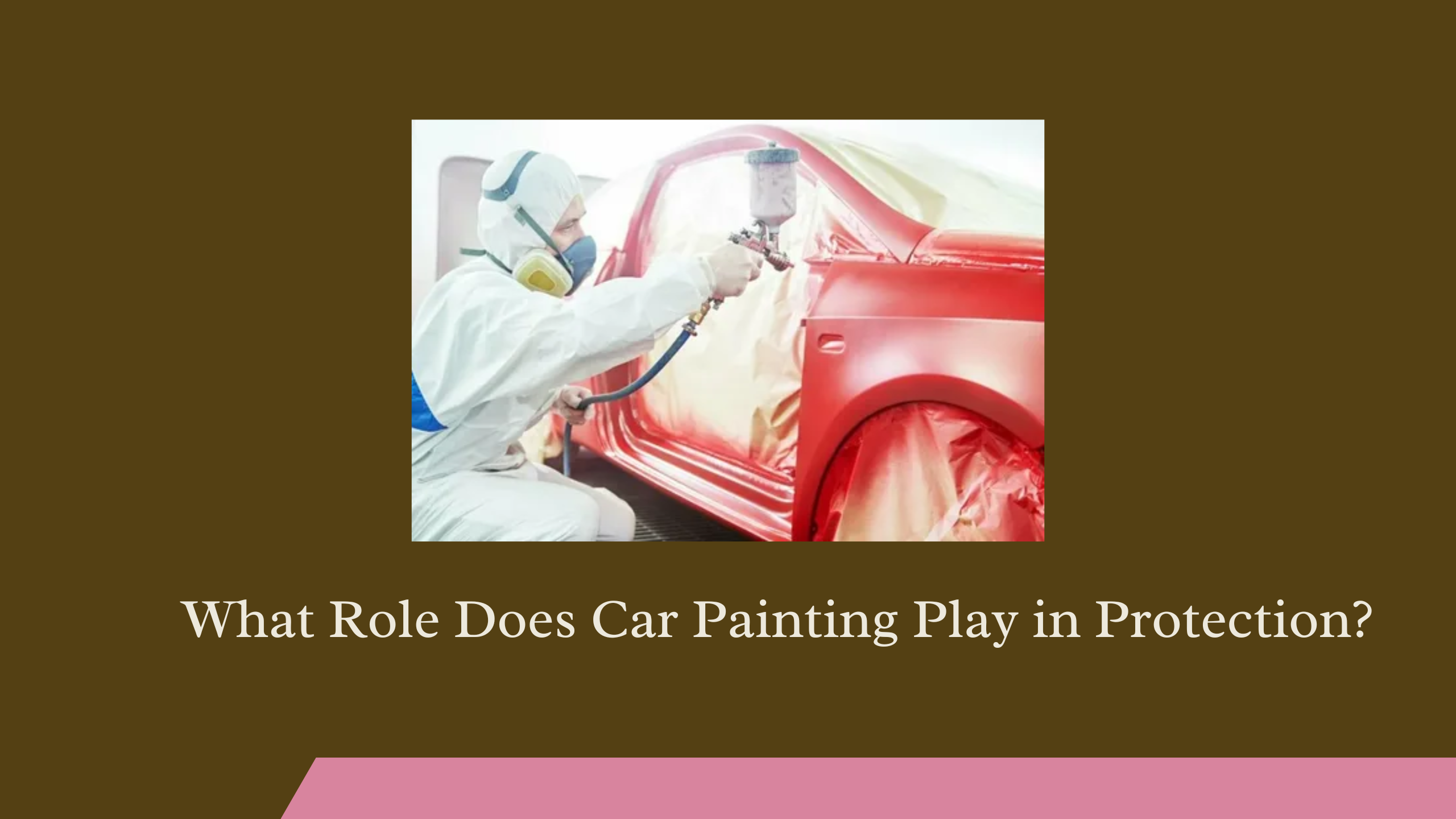What Role Does Car Painting Play in Protection?

Car painting is often seen as a way to enhance the look of a vehicle, giving it a fresh, polished, and appealing finish. However, the role of car paint goes far beyond aesthetics. It serves as a protective shield that guards the vehicle’s body against external damage, environmental hazards, and long-term wear and tear. Modern car painting techniques incorporate advanced materials and technologies designed not only to improve visual appeal but also to extend the lifespan of the car. Understanding the protective role of car paint is crucial for both car owners and automobile businesses.
NOTE :- Car painting Dubai was chosen by customers to restore vehicles with precision and durability. The expert team at Max Garage was trusted for delivering flawless finishes that protected and enhanced every car. Clients were advised to contact Max Garage for reliable painting solutions that extended vehicle life and beauty.
In this article, we will explore in detail how car painting contributes to protection, the different ways it preserves a vehicle, and why it should be considered an essential part of car care and maintenance.
The Protective Function of Car Paint
The first and foremost role of car painting is protection. Vehicles are constantly exposed to external factors such as sunlight, rain, dust, chemicals, and even mechanical scratches. The metal body of a car is highly susceptible to corrosion and rust if left untreated. Car paint forms a barrier between the environment and the vehicle’s metal surface.
The protective layer ensures that external elements do not directly impact the car body. This prevents the formation of rust, minimizes surface damage, and helps maintain structural integrity. Without the paint, the metal surface would deteriorate rapidly, leading to costly repairs or even safety risks over time.
Car Paint as a Defense Against Corrosion
One of the biggest threats to a car’s metal structure is corrosion. When metal is exposed to oxygen and moisture, it undergoes oxidation, which results in rust. Rust not only weakens the structural components but also significantly reduces the resale value of the vehicle.
Car painting acts as a barrier that prevents moisture and air from coming into direct contact with the metal body. Modern automotive paints include multiple layers such as primers, base coats, and clear coats, all working together to provide maximum protection. The primer binds to the surface, the base coat adds color, and the clear coat adds both gloss and resistance against environmental damage.
This multi-layer protection is particularly important in regions with humid climates, frequent rainfall, or exposure to salty air, where corrosion risks are higher.
Protection Against Ultraviolet Rays
Sunlight is another factor that contributes to the deterioration of a vehicle’s body over time. Ultraviolet (UV) rays from the sun can break down the paint molecules and cause the surface to fade, crack, or peel. Prolonged exposure not only diminishes the car’s appearance but also weakens the protective qualities of the paint itself.
High-quality car paints today are designed with UV-resistant formulations. These paints help in absorbing and reflecting UV radiation, preventing damage to the vehicle body. The clear coat applied on top further enhances UV protection, ensuring that the paint remains vibrant and intact for years.
By shielding the car from harmful sun rays, painting plays a significant role in preserving both beauty and durability.
Resistance to Physical Damage
Apart from environmental hazards, cars also face risks of physical damage. Minor scratches, chips, and abrasions are common occurrences due to road debris, accidental contact, or regular use. Car paint provides a protective coating that helps minimize the impact of these small damages.
The clear coat in particular acts as a shield, absorbing minor scratches before they reach the base paint or the underlying metal. While no paint can completely eliminate the risk of physical damage, it does provide a crucial first line of defense. Modern advancements such as scratch-resistant or self-healing paints further enhance this protective capability, making cars more durable in everyday use.
Chemical Resistance and Environmental Pollutants
Vehicles are also exposed to various chemicals and pollutants on the road and in the air. Acid rain, bird droppings, road salts, and industrial fallout all have corrosive properties that can damage a car’s body. If not addressed, these elements can eat into the paint layers and reach the bare metal, leading to severe deterioration.
Car paint plays a crucial role in preventing chemical damage. Quality paints are designed to resist the harmful effects of chemicals, protecting the car from stains, etching, and corrosion. The clear coat adds another level of protection by acting as a sacrificial layer that absorbs initial damage and prevents it from affecting deeper layers.
Regular maintenance, such as waxing and polishing, further enhances this resistance by strengthening the protective barrier created by the paint.
Enhancing Longevity of the Vehicle
A well-painted car is a long-lasting car. Since the paint protects the vehicle from multiple forms of damage, it directly contributes to the longevity of the vehicle. Cars that maintain their original paint finish or receive timely repainting tend to have better structural integrity, higher resale value, and lower long-term maintenance costs.
By preventing rust, corrosion, fading, and chemical damage, car paint ensures that the car remains in good condition for an extended period. This protective function is especially important for owners who plan to keep their vehicles for many years or sell them at a good market value.
Aesthetic Value as an Extension of Protection
Although aesthetics are often considered secondary to protection, the appearance of a vehicle is closely tied to its value and performance. A car with dull, faded, or damaged paint is perceived as neglected, which reduces its market appeal and resale potential.
Fresh, well-maintained paint, on the other hand, not only gives the car an attractive look but also signals proper care and maintenance. This indirectly contributes to the overall protection of the car, as a vehicle that looks good is more likely to be preserved and maintained by its owner.
Thus, the aesthetic role of paint complements its protective role, making it an indispensable feature of automobile care.
The Role of Advanced Car Paint Technologies
Modern technology has transformed car painting into a highly specialized process that offers advanced protection. Innovations such as ceramic coatings, nano-paints, and self-healing finishes have redefined the protective capabilities of paint.
Ceramic coatings, for instance, create an ultra-hard, hydrophobic surface that repels water, dirt, and contaminants. Nano-paints use microscopic particles to create stronger, more flexible coatings that resist scratches and wear. Self-healing paints can automatically repair minor scratches using heat or sunlight, ensuring that the car remains in pristine condition.
These advancements highlight the growing importance of paint not only for beauty but also as a powerful protective technology for vehicles.
The Economic Value of Car Painting
Beyond physical protection, car painting also has economic implications. A well-maintained paint job helps preserve the resale value of the vehicle. Buyers are more inclined to pay higher prices for cars that look visually appealing and show no signs of corrosion or damage.
For businesses such as car rental services, dealerships, and transport companies, maintaining a fleet with high-quality paint ensures better customer satisfaction and sustained profitability. In this way, car paint serves not only as a protective shield but also as an investment in the financial health of vehicle owners and businesses.
Why Regular Maintenance of Car Paint is Essential
While car paint itself provides protection, regular maintenance is necessary to preserve its effectiveness. Washing, waxing, and polishing the car at regular intervals help in maintaining the paint’s protective qualities. Neglecting paint maintenance can lead to fading, chipping, and weakening of the protective layers, making the car vulnerable to external damage.
Professional car detailing and repainting services further enhance the durability of paint. Repainting, in particular, restores both the aesthetic and protective properties of the car, making it an important step for older vehicles or those with extensive paint damage.
Conclusion
Car painting is far more than an aesthetic upgrade. It plays a vital role in protecting vehicles from corrosion, UV damage, physical scratches, chemical pollutants, and long-term deterioration. Modern advancements in car paint technology have elevated its protective capabilities, making it an essential part of vehicle care.
For car owners, maintaining paint quality ensures not only a visually appealing vehicle but also long-term protection, durability, and higher resale value. In a world where vehicles are constantly exposed to harsh conditions, car painting stands as the first and most effective line of defense, proving its value as both protection and investment.
For More Insightful Articles Related To This Topic, Feel Free To Visit: Mifinder
- Art
- Causes
- Crafts
- Dance
- Drinks
- Film
- Fitness
- Food
- Games
- Gardening
- Health
- Home
- Literature
- Music
- Networking
- Other
- Party
- Religion
- Shopping
- Sports
- Theater
- Wellness


